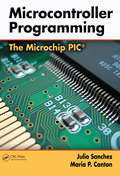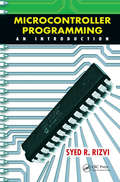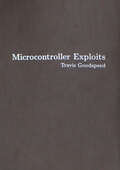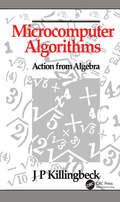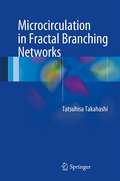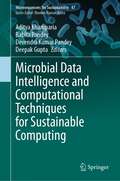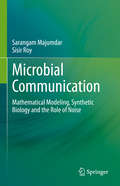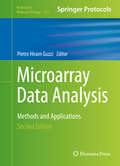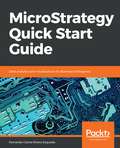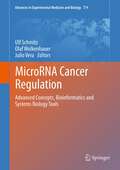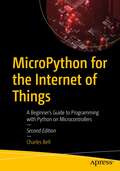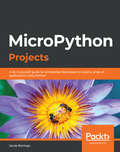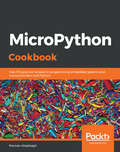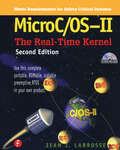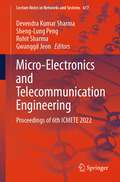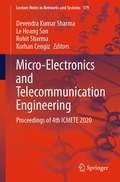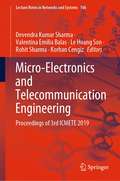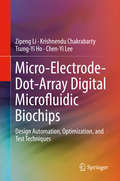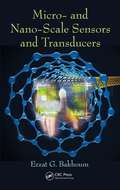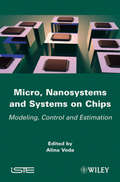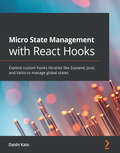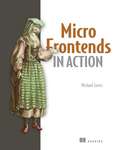- Table View
- List View
Microcontroller Programming: The Microchip PIC
by Julio Sanchez Maria P. CantonFrom cell phones and television remote controls to automobile engines and spacecraft, microcontrollers are everywhere. Programming these prolific devices is a much more involved and integrated task than it is for general-purpose microprocessors; microcontroller programmers must be fluent in application development, systems programming, and I/O operation as well as memory management and system timing. Using the popular and pervasive mid-range 8-bit Microchip PIC® as an archetype, Microcontroller Programming offers a self-contained presentation of the multidisciplinary tools needed to design and implement modern embedded systems and microcontrollers. The authors begin with basic electronics, number systems, and data concepts followed by digital logic, arithmetic, conversions, circuits, and circuit components to build a firm background in the computer science and electronics fundamentals involved in programming microcontrollers.For the remainder of the book, they focus on PIC architecture and programming tools and work systematically through programming various functions, modules, and devices. Helpful appendices supply the full mid-range PIC instruction set as well as additional programming solutions, a guide to resistor color codes, and a concise method for building custom circuit boards.Providing just the right mix of theory and practical guidance, Microcontroller Programming: The Microchip PIC® is the ideal tool for any amateur or professional designing and implementing stand-alone systems for a wide variety of applications.
Microcontroller Programming: An Introduction
by Syed R. RizviMicrocontroller Programming: An Introduction is a comprehensive one-stop resource that covers the concepts, principles, solution development, and associated techniques involved in microcontroller-based systems. Focusing on the elements and features of the popular and powerful Motorola 68HC11 microcontroller IC as a representative example, this book
Microcontroller Exploits
by Travis GoodspeedMicrocontroller Exploits is a deep dive into advanced hardware hacking with detailed examples of real-world techniques and a comprehensive survey of vulnerabilities.In this advanced guide to hardware hacking, you'll learn how to read the software out of single chip computers, especially when they are configured not to allow the firmware to be extracted. This book documents a very wide variety of microchip hacking techniques; it's not a beginner's first introduction.You'll start off by exploring detailed techniques for hacking real-world chips, such as how the STM32F0 allows for one word to be dumped after every reset. You'll see how the STM32F1&’s exception handling can slowly leak the firmware out over an hour, and how the Texas Instruments MSP430 firmware can be extracted by a camera flash.For each exploit, you'll learn how to reproduce the results, dumping a chip in your own lab.In the second half of the book you'll find an encyclopedic survey of vulnerabilities, indexed and cross referenced for use in practicing hardware security.
Microcomputer Software Applications
by Joseph N. Roge Pamela T. Milstead Timothy Selwyn EllisInformation on using the DOS operating system, the WordPerfect editor, and the Quattro spreadsheet program.
Microcomputer Algorithms: Action from Algebra
by John KillingbeckAlthough the computing facilities available to scientists are becoming more powerful, the problems they are addressing are increasingly complex. The mathematical methods for simplifying the computing procedures are therefore as important as ever. Microcomputer Algorithms: Action from Algebra stresses the mathematical basis behind the use of many algorithms of computational mathematics, providing detailed descriptions on how to generate algorithms for a large number of different uses. Covering a wide range of mathematical and physical applications, the book contains the theory of 25 algorithms. The mathematical theory for each algorithm is described in detail prior to discussing the algorithm in full, with complete program listings. The book presents the algorithms in modular form, allowing for easy interpretation, for the adaptation to readers' specific requirements without difficulty, and for use with various microcomputers. Blending mathematics and programming in one volume, this book will be of broad interest to all scientists and engineers, particularly those physicists using microcomputers for scientific problem handling. Students handling numerical data for research projects will also find the book useful.
Microcirculation in Fractal Branching Networks
by Tatsuhisa TakahashiThis book presents a new method for analyzing the structure and function of the biological branching systems of fractal trees, with a focus on microcirculation. Branching systems in humans (vascular and bronchial trees) and those in the natural world (plants, trees, and rivers) are characterized by a fractal nature. To date, fractal studies have tended to concentrate on fractal dimensions, which quantify the complexity of objects, but the applications for practical use have remained largely unexplored. This book breaks new ground with topics that include the human retinal microcirculatory network, oxygen consumption by vascular walls, the Fåhraeus-Lindqvist effect, the bifurcation exponent, and the asymmetrical microvascular network. Readers are provided with simple formulas to express functions and a simulation graph with in vivo data. The book also discusses the mechanisms regulating blood flow and pressure and how they are related to pathological changes in the human body. Researchers and clinicians alike will find valuable new insights in these pioneering studies.
Microbial Data Intelligence and Computational Techniques for Sustainable Computing (Microorganisms for Sustainability #47)
by Deepak Gupta Aditya Khamparia Babita Pandey Devendra Kumar PandeyThis book offers information on intelligent and computational techniques for microbial data associated with plant microbes, human microbes etc. The main focus of this book is to provide an insight on building smart sustainable solutions for microbial technology using intelligent computational techniques. Microbes are ubiquitous in nature, and their interactions among each other are important for colonizing diverse habitats. The core idea of sustainable computing is to deploy algorithms, models, policies and protocols to improve energy efficiency and management of resources, enhancing ecological balance, biological sustenance and other services on societal contexts. Chapters in this book explore the conventional methods as well as the most recently recognized high-throughput technologies which are important for productive agroecosystems to feed the growing global population. This book is of interest to teachers, researchers, microbiologist, computer bioinformatics scientists,plant and environmental scientist, and those interested in environment stewardship around the world. The book also serves as an advanced textbook material for undergraduate and graduate students of computer science, biomedicine, agriculture, human science, forestry, ecology, soil science, and environmental sciences and policy makers.
Microbial Communication: Mathematical Modeling, Synthetic Biology and the Role of Noise
by Sisir Roy Sarangam MajumdarThis book introduces the concept of bacterial communication systems from a mathematical modeling point of view. It sheds light on the research undertaken in the last three decades, and the mathematical models that have been proposed to understand the underlying mechanism of such systems. These communication systems are related to quorum sensing mechanisms and quorum sensing regulated processes such as biofilm formation, gene expression, bioluminescence, swarming and virulence. The book further describes the phenomenon of noise, and discusses how noise plays a crucial role in gene expression and the quorum sensing circuit operationusing a set of tools like frequency domain analysis, power spectral density, stochastic simulation and the whitening effect. It also explores various aspects of synthetic biology (related to bacterial communication), such as genetic toggle switch, bistable gene regulatory networks, transcriptional repressor systems, pattern formation, synthetic cooperation, predator-prey synthetic systems, dynamical quorum sensing, synchronized quorum of genetic clocks, role of noise in synthetic biology, the Turing test and stochastic Turing test.
Microarrays for an Integrative Genomics
by Isaac S. Kohane Alvin Kho Atul J. ButteFunctional genomics--the deconstruction of the genome to determine the biological function of genes and gene interactions--is one of the most fruitful new areas of biology. The growing use of DNA microarrays allows researchers to assess the expression of tens of thousands of genes at a time. This quantitative change has led to qualitative progress in our ability to understand regulatory processes at the cellular level. This book provides a systematic introduction to the use of DNA microarrays as an investigative tool for functional genomics. The presentation is appropriate for readers from biology or bioinformatics. After presenting a framework for the design of microarray-driven functional genomics experiments, the book discusses the foundations for analyzing microarray data sets, genomic data-mining, the creation of standardized nomenclature and data models, clinical applications of functional genomics research, and the future of functional genomics.
Microarray Data Analysis
by Pietro Hiram GuzziThis volume covers a large area, from the description of methodologies for data analysis to the real application. Chapters focus on methodologies for preprocessing of microarray data, a survey of miRNA Data analysis, Cloud-based approaches, application of data mining techniques for data analysis, biclustering to query different datasets, web-based tool to analyze the evolution of miRNA clusters, application of biclustering to mine patterns of co-regulated genes ontologies, microarray and proteomic Data, Gene Regulatory Network Inference, Gene Regulatory Network methods, analysis of Mouse data for metabolomics studies, analysis of microRNA data in Multiple Myeloma, microarray data analysis in Gliobastomas, and microRNA data in Cardiogenesis. Written for the Methods in Molecular Biology series, chapters include introductions to their respective topics, lists of the necessary materials and reagents, step-by-step, readily reproducible laboratory protocols, and tips on troubleshooting and avoiding known pitfalls. Authoritative and practical, Microarray Data Analysis: Methods and Applications, Second Edition aims to ensure successful results in the further study of this vital field.
MicroStrategy Quick Start Guide: Data analytics and visualizations for Business Intelligence
by Fernando Carlos Rivero EsquedaBuild reporting applications and dashboards using the different MicroStrategy objectsKey FeaturesLearn the fundamentals of MicroStrategyUse MicroStrategy to get actionable insights from your business dataCreate visualizations and build intuitive dashboards and reportsBook DescriptionMicroStrategy is an enterprise business intelligence application. It turns data into reports for making and executing key organization decisions. This book shows you how to implement Business Intelligence (BI) with MicroStrategy. It takes you from setting up and configuring MicroStrategy to security and administration.The book starts by detailing the different components of the MicroStrategy platform, and the key concepts of Metadata and Project Source. You will then install and configure MicroStrategy and lay down the foundations for building MicroStrategy BI solutions. By learning about objects and different object types, you will develop a strong understanding of the MicroStrategy Schema and Public Objects. With these MicroStrategy objects, you will enhance and scale your BI and Analytics solutions.Finally, you will learn about the administration, security, and monitoring of your BI solution.What you will learnSet up the MicroStrategy Intelligence Server and client toolsCreate a MicroStrategy metadata repository and your first ProjectExplore the main MicroStrategy object types and their dependencies Create, manipulate, and share ReportsCreate and share DashboardsManage Users and GroupsWho this book is forThis book is for Business Intelligence professionals or data analysts who want to get started with Microstrategy. Some basic understanding of BI and data analysis will be required to get the most from this book.
MicroRNA Cancer Regulation
by Ulf Schmitz Olaf Wolkenhauer Julio VeraThis edited reflects the current state of knowledge about the role of microRNAs in the formation and progression of solid tumours. The main focus lies on computational methods and applications, together with cutting edge experimental techniques that are used to approach all aspects of microRNA regulation in cancer. We are sure that the emergence of high-throughput quantitative techniques will make this integrative approach absolutely necessary in the near future. This book will be a resource for researchers starting out with cancer microRNA research, but is also intended for the experienced researcher who wants to incorporate concepts and tools from systems biology and bioinformatics into his work. Bioinformaticians and modellers are provided with a general perspective on microRNA biology in cancer, and the state-of-the-art in computational microRNA biology.
MicroPython for the Internet of Things: A Beginner’s Guide to Programming with Python on Microcontrollers
by Charles BellThis book will help you quickly learn to program for microcontrollers and IoT devices without a lot of study and expense. MicroPython and controllers that support it eliminate the need for programming in a C-like language, making the creation of IoT applications and devices easier and more accessible than ever. MicroPython for the Internet of Things is ideal for readers new to electronics and the world of IoT. Specific examples are provided covering a range of supported devices, sensors, and MicroPython boards such as the Raspberry Pi Pico and the Arduino Nano Connect RP2040 board. Programming for microcontrollers has never been easier. The book takes a practical and hands-on approach without a lot of detours into the depths of theory. It’ll show you a faster and easier way to program microcontrollers and IoT devices, teach you MicroPython, a variant of one of the most widely used scripting languages, and is written to be accessible to those new to electronics. After completing this book, and its fun example projects, you’ll be ready to ready to use MicroPython to develop your own IoT applications. What You Will Learn Program in MicroPython Understand sensors and basic electronics Develop your own IoT projects Build applications for popular boards such as Raspberry Pi Pico and Arduino Nano Connect RP2040 Load MicroPython on compatible boards Interface with hardware breakout boards Connect hardware to software through MicroPython Explore connecting your microcontroller to the cloud Develop IoT projects for the cloud Who This Book Is For Anyone interested in building IoT solutions without the heavy burden of programming in C++ or C. The book also appeals to those wanting an easier way to work with hardware than is provided by platforms that require more complex programming environments.
MicroPython Projects: A do-it-yourself guide for embedded developers to build a range of applications using Python
by Jacob BeningoExplore MicroPython through a series of hands-on projects and learn to design and build your own embedded systems using the MicroPython Pyboard, ESP32, the STM32 IoT Discovery kit, and the OpenMV camera module. Key Features Delve into MicroPython Kernel and learn to make modifications that will enhance your embedded applications Design and implement drivers to interact with a variety of sensors and devices Build low-cost projects such as DIY automation and object detection with machine learning Book Description With the increasing complexity of embedded systems seen over the past few years, developers are looking for ways to manage them easily by solving problems without spending a lot of time on finding supported peripherals. MicroPython is an efficient and lean implementation of the Python 3 programming language, which is optimized to run on microcontrollers. MicroPython Projects will guide you in building and managing your embedded systems with ease. This book is a comprehensive project-based guide that will help you build a wide range of projects and give you the confidence to design complex projects spanning new areas of technology such as electronic applications, automation devices, and IoT applications. While building seven engaging projects, you'll learn how to enable devices to communicate with each other, access and control devices over a TCP/IP socket, and store and retrieve data. The complexity will increase progressively as you work on different projects, covering areas such as driver design, sensor interfacing, and MicroPython kernel customization. By the end of this MicroPython book, you'll be able to develop industry-standard embedded systems and keep up with the evolution of the Internet of Things. What you will learn Develop embedded systems using MicroPython Build a custom debugging tool to visualize sensor data in real-time Detect objects using machine learning and MicroPython Discover how to minimize project costs and reduce development time Get to grips with gesture operations and parsing gesture data Learn how to customize and deploy the MicroPython kernel Explore the techniques for scheduling application tasks and activities Who this book is for If you are an embedded developer or hobbyist looking to build interesting projects using MicroPython, this book is for you. A basic understanding of electronics and Python is required while some MicroPython experience will be helpful.
MicroPython Cookbook: Over 110 practical recipes for programming embedded systems and microcontrollers with Python
by Marwan AlsabbaghLearn how you can control LEDs, make music, and read sensor data using popular microcontrollers such as Adafruit Circuit Playground, ESP8266, and the BBC micro:bitKey FeaturesLoad and execute your first program with MicroPythonProgram an IoT device to retrieve weather data using a RESTful APIGet to grips with integrating hardware, programming, and networking concepts with MicroPythonBook DescriptionMicroPython is an open source implementation of Python 3 that runs in embedded environments. With MicroPython, you can write clean and simple Python code to control hardware instead of using complex low-level languages such as C and C++. This book guides you through all the major applications of the MicroPython platform to build and program projects that use microcontrollers. This MicroPython book covers recipes that will help you experiment with the programming environment and hardware programmed in MicroPython. You'll find tips and techniques for building a variety of objects and prototypes that can sense and respond to touch, sound, position, heat, and light. This book will take you through the uses of MicroPython with a variety of popular input devices and sensors. You'll learn techniques to handle time delays and sensor readings, and apply advanced coding techniques to create complex projects. As you advance, you'll deal with Internet of Things (IoT) devices and integration with other online web services. In addition to this, you'll use MicroPython to make music with bananas and create portable multiplayer video games that incorporate sound and light animations into the gameplay. By the end of this book, you'll have mastered the tips and tricks to troubleshoot your development problems and take your MicroPython project to the next level.What you will learnExecute code without any need for compiling or uploading using REPL (read-evaluate-print-loop)Program and control LED matrix and NeoPixel drivers to display patterns and colorsBuild projects that make use of light, temperature, and touch sensorsConfigure devices to create Wi-Fi access points and use network modules to scan and connect to existing networksUse Pulse width modulation to control DC motors and servosBuild an IoT device to display live weather data from the internet at the touch of a buttonWho this book is forIf you want to build and program projects that use microcontrollers, this book will offer you dozens of recipes to guide you through all the major applications of the MicroPython platform. Although no knowledge of MicroPython or microcontrollers is expected, a general understanding of Python is necessary to get started with this book.
MicroC/OS-II: The Real Time Kernel
by Jean LabrosseMicroC/OS II Second Edition describes the design and implementation of the MicroC/OS-II real-time operating system (RTOS). In addition to its value as a reference to the kernel, it is an extremely detailed and highly readable design study particularly useful to the embedded systems student. While documenting the design and implementation of the kernel, the book also walks the reader through the many related development issues: how to adapt the kernel for a new microprocessor, how to install the kernel, and how to structure the applications that run on the kernel. This edition features documentation for several important new features of the software, including new real-time services, floating points, and coding conventions. The accompanying downloadable resources include complete code for the MicroC/OS-II kernel.
Micro-Electronics and Telecommunication Engineering: Proceedings of 6th ICMETE 2022 (Lecture Notes in Networks and Systems #617)
by Rohit Sharma Sheng-Lung Peng Devendra Kumar Sharma Gwanggil JeonThe book presents high-quality papers from the Sixth International Conference on Microelectronics and Telecommunication Engineering (ICMETE 2022). It discusses the latest technological trends and advances in major research areas such as microelectronics, wireless communications, optical communication, signal processing, image processing, big data, cloud computing, artificial intelligence, and sensor network applications. This book includes the contributions of national and international scientists, researchers, and engineers from both academia and the industry. The contents of this book are useful to researchers, professionals, and students alike.
Micro-Electronics and Telecommunication Engineering: Proceedings of 4th ICMETE 2020 (Lecture Notes in Networks and Systems #179)
by Rohit Sharma Devendra Kumar Sharma Le Hoang Son Korhan CengizThis book presents selected papers from the 4th International Conference on Micro-Electronics and Telecommunication Engineering, held at SRM Institute of Science and Technology, Ghaziabad, India, during 26–27 September 2020. It covers a wide variety of topics in micro-electronics and telecommunication engineering, including micro-electronic engineering, computational remote sensing, computer science and intelligent systems, signal and image processing, and information and communication technology.
Micro-Electronics and Telecommunication Engineering: Proceedings of 3rd ICMETE 2019 (Lecture Notes in Networks and Systems #106)
by Rohit Sharma Valentina Emilia Balas Devendra Kumar Sharma Le Hoang Son Korhan CengizThis book presents selected papers from the 3rd International Conference on Micro-Electronics and Telecommunication Engineering, held at SRM Institute of Science and Technology, Ghaziabad, India, on 30-31 August 2019. It covers a wide variety of topics in micro-electronics and telecommunication engineering, including micro-electronic engineering, computational remote sensing, computer science and intelligent systems, signal and image processing, and information and communication technology.
Micro-Electrode-Dot-Array Digital Microfluidic Biochips: Design Automation, Optimization, And Test Techniques
by Krishnendu Chakrabarty Tsung-Yi Ho Zipeng Li Chen-Yi LeeThis book provides an insightful guide to the design, testing and optimization of micro-electrode-dot-array (MEDA) digital microfluidic biochips. The authors focus on the characteristics specific for MEDA biochips, e.g., real-time sensing and advanced microfluidic operations like lamination mixing and droplet shape morphing. Readers will be enabled to enhance the automated design and use of MEDA and to develop a set of solutions to facilitate the full exploitation of design complexities that are possible with standard CMOS fabrication techniques. The book provides the first set of design automation and test techniques for MEDA biochips. The methods described in this book have been validated using fabricated MEDA biochips in the laboratory. Readers will benefit from an in-depth look at the MEDA platform and how to combine microfluidics with software, e.g., applying biomolecular protocols to software-controlled and cyberphysical microfluidic biochips.
Micro- and Nano-Scale Sensors and Transducers
by Ezzat G. BakhoumThe rapidly emerging fields of nanotechnology and nano-fabrication have enabled the creation of new sensors with dramatic improvements in sensitivity and range, along with substantial miniaturization. And, although there are many books on nanotechnology, recent advances in micro and nano-scale sensors and transducers are not adequately represented
Micro, Nanosystems and Systems on Chips: Modeling, Control, and Estimation (Wiley-iste Ser.)
by Alina VodaMicro and nanosystems represent a major scientific and technological challenge, with actual and potential applications in almost all fields of the human activity. The aim of the present book is to present how concepts from dynamical control systems (modeling, estimation, observation, identification, feedback control) can be adapted and applied to the development of original very small-scale systems and of their human interfaces. The application fields presented here come from micro and nanorobotics, biochips, near-field microscopy (AFM and STM) and nanosystems networks. Alina Voda has drawn contributions from leading experts at top research universities in France to produce a first overview of the major role that control systems science can play in the development of micro and nanosciences and technologies.
Micro State Management with React Hooks: Explore custom hooks libraries like Zustand, Jotai, and Valtio to manage global states
by Daishi KatoExplore global state management and select the best library for your applicationKey FeaturesUnderstand the essential concepts and features of micro state managementDiscover solutions to common problems faced while implementing micro state managementExplore the different libraries, their coding style, and the optimum approach to rendering optimizationBook DescriptionState management is one of the most complex concepts in React. Traditionally, developers have used monolithic state management solutions. Thanks to React Hooks, micro state management is something tuned for moving your application from a monolith to a microservice.This book provides a hands-on approach to the implementation of micro state management that will have you up and running and productive in no time. You'll learn basic patterns for state management in React and understand how to overcome the challenges encountered when you need to make the state global. Later chapters will show you how slicing a state into pieces is the way to overcome limitations. Using hooks, you'll see how you can easily reuse logic and have several solutions for specific domains, such as form state and server cache state. Finally, you'll explore how to use libraries such as Zustand, Jotai, and Valtio to organize state and manage development efficiently.By the end of this React book, you'll have learned how to choose the right global state management solution for your app requirement.What you will learnUnderstand micro state management and how you can deal with global stateBuild libraries using micro state management along with React HooksDiscover how micro approaches are easy using React HooksUnderstand the difference between component state and module stateExplore several approaches for implementing a global stateBecome well-versed with concrete examples and libraries such as Zustand, Jotai, and ValtioWho this book is forIf you're a React developer dealing with complex global state management solutions and want to learn how to choose the best alternative based on your requirements, this book is for you. Basic knowledge of JavaScript programming, React Hooks and TypeScript is assumed.
Micro Frontends in Action
by Michael GeersMicro Frontends in Action teaches you to apply the microservices approach to the frontend.Summary Browser-based software can quickly become complex and difficult to maintain, especially when it&’s implemented as a large single-page application. By adopting the micro frontends approach and designing your web apps as systems of features, you can deliver faster feature development, easier upgrades, and pick and choose the technology you use in your stack. Micro Frontends in Action is your guide to simplifying unwieldy frontends by composing them from small, well-defined units. Purchase of the print book includes a free eBook in PDF, Kindle, and ePub formats from Manning Publications. About the Technology Micro frontends deliver the same flexibility and maintainability to browser-based applications that microservices provide for backend systems. You design your project as a set of standalone components that include their own interfaces, logic, and storage. Then you develop these mini-applications independently and compose them in the browser. About the Book Micro Frontends in Action teaches you to apply the microservices approach to the frontend. You&’ll start with the core micro frontend design ideas. Then, you&’ll build an e-commerce application, working through practical issues like server-side and client-side composition, routing, and maintaining a consistent look and feel. Finally, you&’ll explore team workflow patterns that maximize the benefit of developing application components independently. What&’s Inside - Create a unified frontend from independent applications - Combine JavaScript code from multiple frameworks - Browser and server-side composition and routing - Implement effective dev teams and project workflow About the Reader For web developers, software architects, and team leaders. About the Author Michael Geers is a software developer specializing in building user interfaces. Table of Contents PART 1 - GETTING STARTED WITH MICRO FRONTENDS 1 What are micro frontends? 2 My first micro frontends project PART 2 - ROUTING, COMPOSITION, AND COMMUNICATION 3 Composition with Ajax and server-side routing 4 Server-side composition 5 Client-side composition 6 Communication patterns 7 Client-side routing and the application shell 8 Composition and universal rendering 9 Which architecture fits my project? PART 3 - HOW TO BE FAST, CONSISTENT, AND EFFECTIVE 10 Asset loading 11 Performance is key 12 User interface and design system 13 Teams and boundaries 14 Migration, local development, and testing
Michel Ocelot: A World of Animated Images
by Laura BuonoThis unique book examines the career of Michel Ocelot, from his earliest works to his latest research and productions, including an interview regarding his latest film Le Pharaon, le Sauvage et la Princesse (2022). The book highlights the director’s role in the panorama of contemporary animated cinema and his relationship with the tradition, both artistic and cinematographic. The book carefully analyses the ethical and social nature of Ocelot’s work to underscore the duality of the director’s oeuvre, both artistic and social, using an interdisciplinary approach that blends film and aesthetic criticism with gender studies and decolonial thought. Particular attention will be given to the themes of multiculturalism, discrimination, and treatment of women, which are at the centre of many current cultural debates. The book will be of interest to an audience of experts, animation enthusiasts, and film scholars, as well as to a wider readership interested in learning about the poetics of Kirikou’s father.
